Introduction to Electromagnetic waves and electromagnetic spectrum
Waves are categorized into three main types, mechanical, electromagnetic, and matter waves. The waves that can pass through a medium are called mechanical waves. Whereas, electromagnetic waves (EM Waves), a special type of wave, do not require a medium to travel or propagate. EM waves don’t need fluid, or solid, or even air to help them travel from one place to another and this is why EM waves can travel across the vacuum of space.
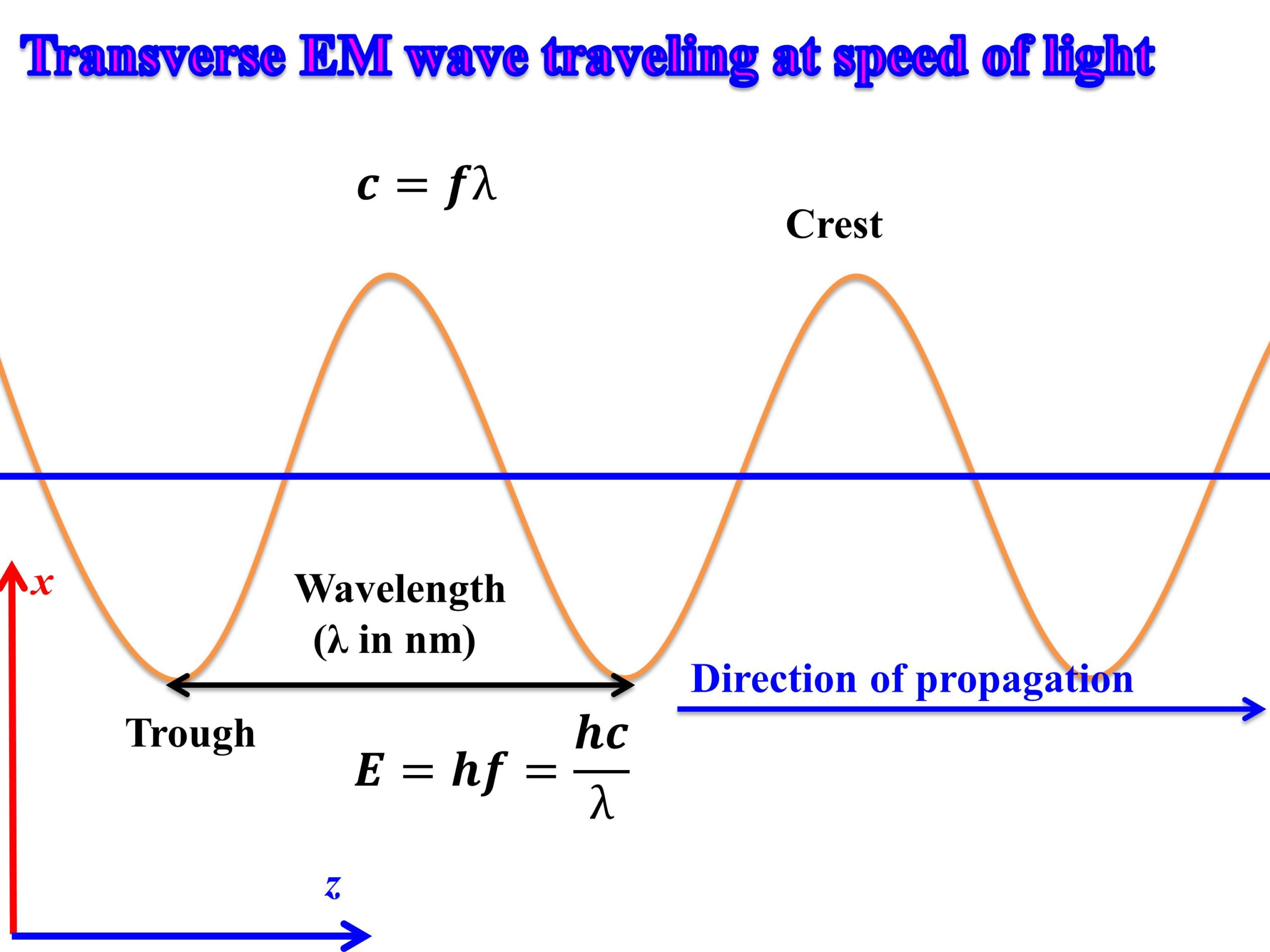
Electromagnetic waves are transverse waves (shown in Fig. 1) in nature and are measured by their amplitude, and wavelength, or the distance between the highest point of one wave and the next wave (Crest). The lowest point of a wave is called a trough. From the nomenclature, it is understood that EM waves consist of two main components i.e., electric and magnetic. The electromagnetic waves are originated when particles are charged which results in the creation of an electric field. This charged particle creates an electric field and pushes the adjacent charged particle. As it accelerates, the charged particle generates oscillations, in an electric field, and simultaneously produce produces a magnetic field, and finally results in an emission of energy known as electromagnetic radiation.
Electromagnetic waves propagate outward from the source. The movement of electromagnetic waves is perpendicular to the direction of the wave’s movement. However, EM waves are a bit sophisticated; the electric component oscillates in one plane, while the magnetic component oscillates in a different plane. James Clerk Maxwell discovered the relationship between electrical and magnetic fields which can be coupled together in the form of electromagnetic waves which are known as “Maxwell’s Equations“. The two major Maxwell’s equations (derived from Faraday’s law and Ampere’s law) are key to understanding how an electromagnetic wave travels without a medium. Both of these laws are written below.
Where ∇ is the nabla or del operator, E is the electric field, B is the magnetic flux density related to Magnetic field H and permeability by formula B=μH, J is the current density and D is the electric flux density related to E and permittivity ε by the formula D=εE. For free space, since there is no charge density, J goes to 0. These two equations tell us that change in the electric field produced a change in a magnetic field and therefore, both of these fields sustain each other in free space. That is why electromagnetic waves can travel through free space.
Heinrich Hertz applied Maxwell’s theories and revealed that the velocity of radio and light waves is equal to the velocity of light and proved that radio waves were a form of light. On the basis of energy and frequency, EM waves can be categorized as ionizing radiations or non-ionizing radiations.
Ionizing radiations have an extremely high frequency with photon energy and produce ionization as a result of breaking the atomic bonds. Non-ionizing radiations have very weak photon energies to break atomic bonds. The energy of a wave can be calculated by a simple relationship that relates frequency (f) and energy (E) by a proportionality constant of h (Planck’s constant).
Characteristics of Electromagnetic Waves
- Since the change in electric field yields changes in a magnetic field, an accelerated charge results in a time-varying magnetic field.
- Similarly, it also produces a time-varying electric field.
- EM waves are transverse in nature as both fields are perpendicular to each other.
- Accelerated charges are responsible to produce electromagnetic waves.
- EM Waves have constant velocity in a vacuum and it is nearly equal to 3×108 m/s but more accurately it is 299 792 458 m/s.
- EM wave propagation is not dependent on material for propagation.
- As EM waves travel from one medium to another medium, their frequencies remain unaffected while their wavelength alters.
- Electromagnetic waves follow the principle of superposition.
- The light vector (also known as the electric vector) is the reason for the optical effects due to an electromagnetic wave.
- During oscillating of EM waves, the electric and magnetic fields remain in phase with constant ratio of magnitude.
- Electric and magnetic fields in electromagnetic waves carry equal energy. The electric energy (uE) and magnetic energy (uM) are equal which mean uE = uM.
- EM waves have the ability to transfer their energy from one place to another, similar to other waves.
- EM Waves can also be reflected and refracted.
Electromagnetic Spectrum
A general rule, frequency, and wavelength are inversely proportional, and the same principle also applies to EM waves like other waves which means that the higher the frequency; the lower will be the wavelength. The electromagnetic spectrum is a continuous range of wavelengths. This can be understood by the formula relating the speed of light (c) with frequency (f) and wavelength (λ).
EM waves are mainly divided into 7 major categories and the same are arranged in order of decreasing wavelength / increasing frequency as shown in Table 1.
| Radiation Name | Energy (eV) | Wavelength (m) | Frequency (Hz) |
| Gamma waves | greater than 1.24 x 106 | less than 10-12 | 1020-1024 |
| X-ray waves | 103-1.24 x 106 | 10-12-10-9 | 1017-1020 |
| Ultraviolet waves | 3.1- 103 | 10-9-400 x 10-9 | 1015-1017 |
| Visible waves | 1.77-3.1 | 400 x 10-9-700 x 10-9 | 4 x 1014-7.5 x 1014 |
| Infrared waves | 4.96 x 10-2-1.77 | 700 x 10-9-25 x 10-6 | 1 x 1011-4 x 1014 |
| Microwaves | 1.24 x 10-3-4.96 x 10-2 | 25 x 10-6-1 x 10-3 | 3 x 109-1011 |
| Radio waves | less than 1.24 x 10-3 | greater than 1 x 10-3 | less than 3 x 109 |
The Electromagnetic spectrum and its seven main categories of electromagnetic waves are shown in Fig. 2.
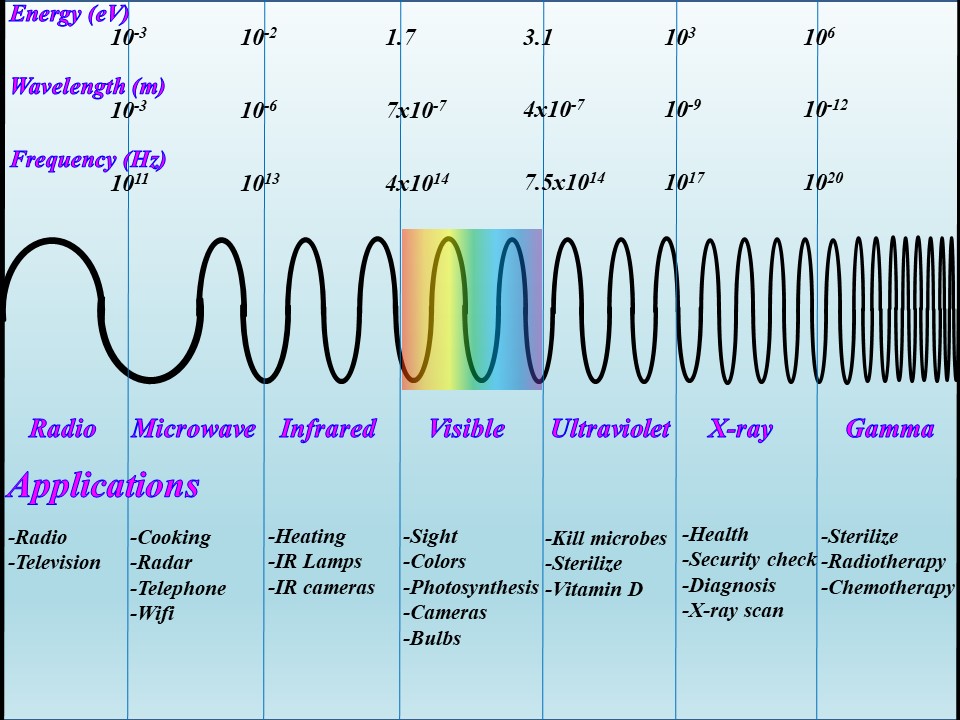
Applications of EM Spectrum
Radio waves in electromagnetic spectrum
Radio Waves are the most commonly used waves that we experienced in our daily life amongst the electromagnetic spectrum. These waves have frequencies ranging from 3 Hz to 1 GHz. Their wavelength minimum is about 30 cm.
Radio spectrum is further divided into 12 bands per International Telecommunication Union (ITU), with wavelength starting from (10n) meters which further decrease with an increase in frequency. The lowest frequency band in the radio spectrum is Extremely Low Frequency (ELF). EM waves are generated as a result of accelerating charge in the AC currents of electrical power lines.
ELF (3 – 30 Hz), Super Low Frequency (SLF) (30 – 300 Hz), and Ultra Low-Frequency (ULF) waves (300 – 3000 Hz) are able to penetrate seawater and therefore are useful for submarine communications. Very Low Frequency (VLF) Waves (3 kHz – 30 kHz) have frequencies higher than ULF and these are used for navigation purposes, time signals, submarine communication, wireless heart rate monitors. To utilize EM waves for the transmission of information, a modulation technique is utilized which can be either amplitude, frequency, or phase-amplitude. The waves are modulated and later on, these are demodulated at the far end to transfer information.
Low Frequency (LF) has a frequency range from 30KHz – 300 KHz and is used in Navigation like Non-directional Beacon (NDB), AM long-wave broadcasting, RFID for access systems. Medium Frequency (MF) (300 kHz to 3000 kHz) are used in AM (medium-wave) broadcasts, amateur radio. High Frequency (HF) (3 MHz – 30 MHz) are used in broadcasts, amateur radio and over-the-horizon aviation communications, RFID, over-the-horizon radar, Automatic Link Establishment (ALE). These waves utilize the ionosphere for transmission. A commonly used HF set in the military is PRC-786 which are utilized in hilly terrain and remote location for prompt communication.
Communication in VHF (30MHz – 300MHz) is based on line of sight. Various types of VHF radios are used at ATC towers for the exchange of R/T and also send meteorological status in audio form to the pilot when the aircraft is in close vicinity of the airport. These are also used in FM, Television broadcast Ground to Air / Air to Air Communication, land mobile, and maritime mobile communications.
UHF (300MHz – 3000MHz) communication also works on the line on sight. Mainly utilized in Television broadcasts which we find while manual tuning, microwave oven, microwave devices/communications, Grd to Air and Air to Air Radio, mobile phones, wireless LAN, Bluetooth, GPS. Advanced digital two-way land mobile radio (Walke Talkie) communication having TDM features also operates in the same band. The utilization of SHF (3GHz – 30 GHz) can be found in microwave devices WLAN, radars, communications satellites, cable, and satellite television broadcasting.
The utilization of EHF (30 GHz – 300GHz) can be found as a high-frequency microwave radio relay to transfer the information at the far end where the direct line on sight is not possible or distance is too much and signals losses its strength. Moreover, it is also used in microwave remote sensing, directed-energy weapons, millimeter-wave scanner, Wireless LANs.
The highest frequency band in radio waves is THF (300GHz- 3000GHz). Due to the highest frequency, these are harmful to humans but at the experimental level, they can replace X-rays, terahertz computing/communications, remote sensing. Communication through cell phones is the most common source of communication. The famous 2G, 2.5G, 3G, 4G, and 5G of mobile generations for voice and data communication come under the radio frequency band.
Microwaves in electromagnetic spectrum
Microwaves frequencies range from 109 Hz to 1012 Hz. Radar is a common application of microwaves. Military, Air Traffic control Radar ad Doppler Weather radar uses the microwave. Each radar has its own coverage and capability depending upon frequency. Frequency also plays an important role in categorizing Long Range, Medium range, or Short-range radar. We can find applications commonly in microwave ovens in houses for heating food.
WiFi is commonly used to connect devices to access the internet wirelessly at different locations. Bluetooth 2.4 GHz also provides wireless connectivity to transfer data between devices in close vicinity. RFID (radio frequency identification) also used microwaves which can be utilized to provide access systems. NFC (near field communication) uses a microwave to share data between terminals that are very close.
Infrared waves
Infrared mean below red. These are used by Reconnaissance satellites to detect specific areas of interest by their infrared emissions. Infrared lamps are used to provide a warm effect. IR cameras are used in security setup to provide images even in dark. Remote Control in houses also uses IR for changing channels on TV or adjusting the temperature on AC.
Dispersion of Light and Visible spectrum
All that we see around us is due to the presence of light and it’s considered to be an important aspect of this universe. It also falls under the electromagnetic spectrum. Light comprises seven main colors. The existence of even color can be seen when White light is passed through a prism. As the property of refraction, the colors having different wavelength/ frequency refract or in other words bend differently. This phenomenon is due to the different speeds of colors when traveling through the glass.
A segment of seven colors can be seen in the sky as a rainbow after the rain. As the droplets of water in the atmosphere acts as a prism and when sunlight passes through that segment, then seven colors appear in the arc form. Red light is refracted least as it slowed down least by glass and Violet light is refracted most as it is slowed down most by the glass. The practical example of visible light is the bulb.
Ultraviolet waves
In ultraviolet, the wavelengths extend from 400nm to 10nm at their highest frequencies. Ultraviolet is generally generated by the motion of atoms and molecules. UV radiation which is received from the Sun is mainly categorized into three types on the basis of wavelength. UV-A (320- 400nm), UV-B (290 -320nm) UV-C (220 -290nm). 99% of UV-A from the sun reaches the earth due to the high absorption of UV-B and UV-C by the ozone layer.
Ultraviolet rays can be used to kill microbes. Hospitals use UV lamps to sterilize surgical equipment and the air in operating theatres. UV lamps are also used to sterilize food and drugs. Suitable doses of Ultraviolet rays cause the body to produce vitamin D, and this is used by doctors to treat vitamin D deficiency and some skin disorders.
The particular dye fluoresces and emits visible light when exposed to UV light. The same phenomena can be seen money machines identify the tampered or fake currency. UV attracts insects, which are electrocuted by high-voltage wires near the lamp. UV light is also used with a water filter to purify the water.
X-ray waves
X-rays have wavelengths ranging from 10-8 m to 10-12 m and have the capability to transfer atomic energy. Due to this phenomenon, it divides the cells and is used to diagnose and treatment of cancer. The most common use x–rays are experienced in hospitals. Whenever, any pain in the joint or fracture of a bone, an X-ray room is the perfect option to identify the affected area. X-rays of the human body and aircraft parts are used to assess the body/structure health. X-rays are also used in airport security checks, to see inside your luggage.
Gamma ray waves in electromagnetic spectrum
Among the EM waves, Gamma Rays stand at the top with an extremely highest frequency which leads to the highest penetrating capability. Characteristics of Gamma rays are similar to X-rays but they differ in source generation (from the nucleus). Gamma rays, due to the penetration and energy, are used to damage living cells in the human body. That’s the reason, gamma rays are exposed to the body at a particular location for a short duration to kill cancer cells. Radiotherapy or chemotherapy uses gamma rays for the treatment of cancer in place of complex surgery.
It can also be used as a tracer where doctors can put slightly radioactive substances into a patient’s body, then scan the patient to detect the gamma rays and build up a picture of what’s going on inside the patient. Gamma rays kill microbes and are used to sterilize food so that it will keep fresh for longer.
Further Readings
If you liked this post, you might be interested in reading the following posts.
- Construction, working, and new technologies of OLED TV
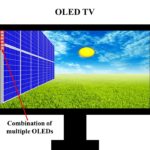
- Laser and its applications in medicine and technology
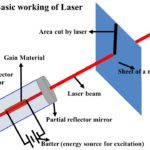
- LED light, its construction, types and colors, power, life, and technology
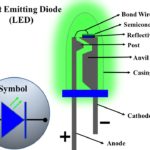
- Optical fiber design and applications
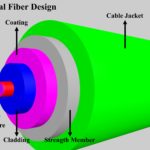
- Radiation therapy for cancer treatment and its side effects


Having read this I thought it was rather enlightening. I appreciate you spending some time and energy to put this information together. I once again find myself spending a significant amount of time both reading and leaving comments. But so what, it was still worth it!